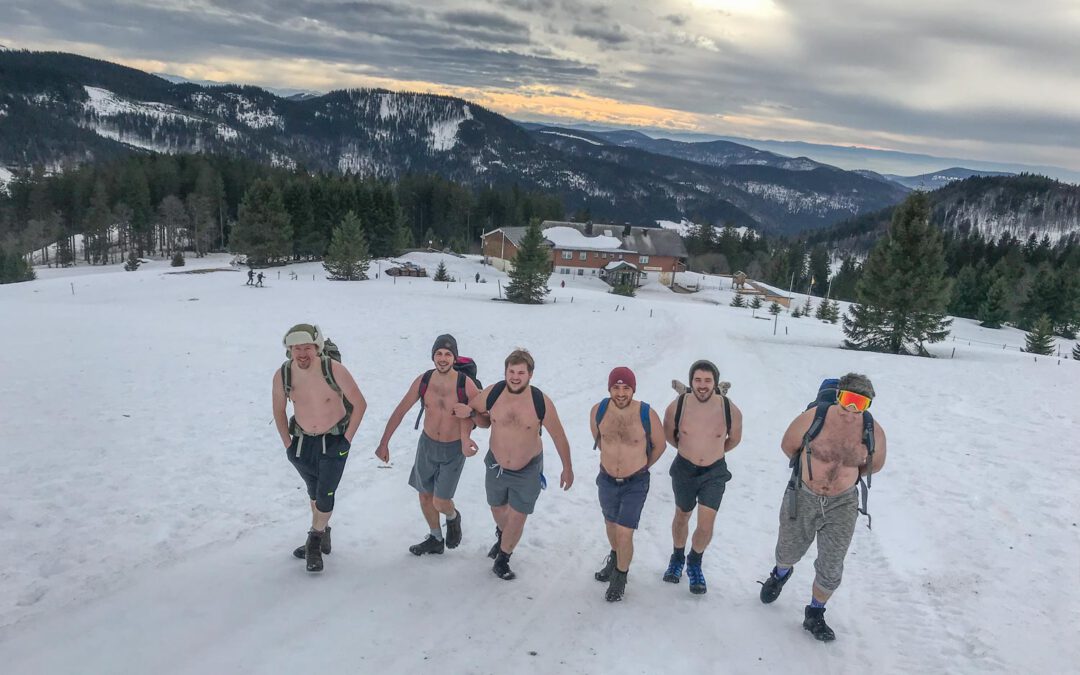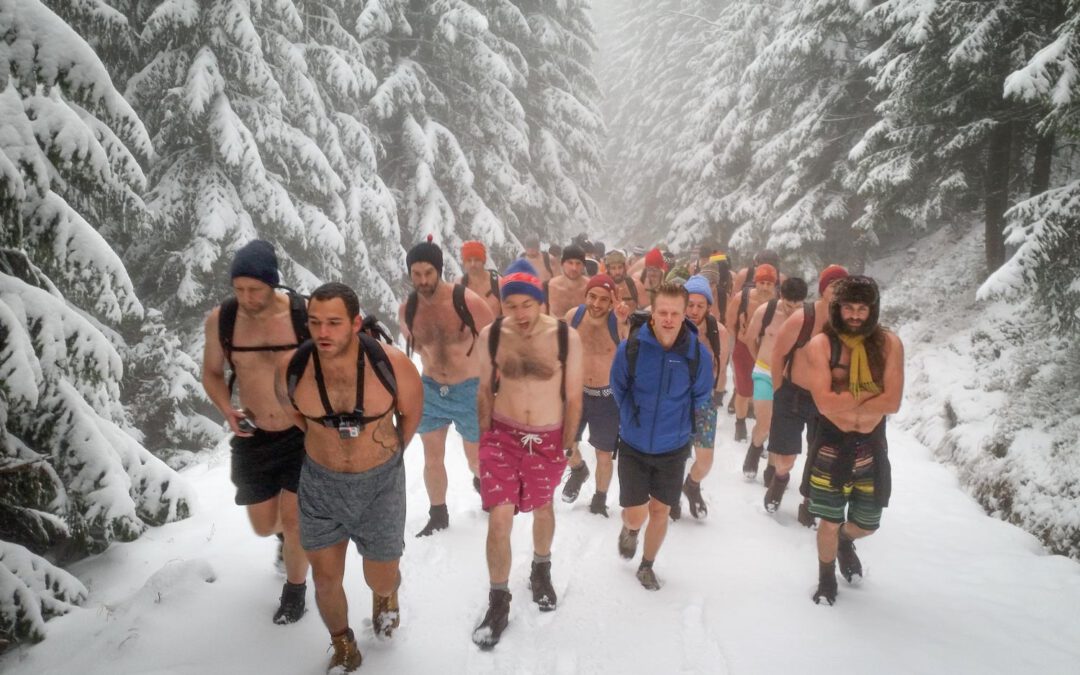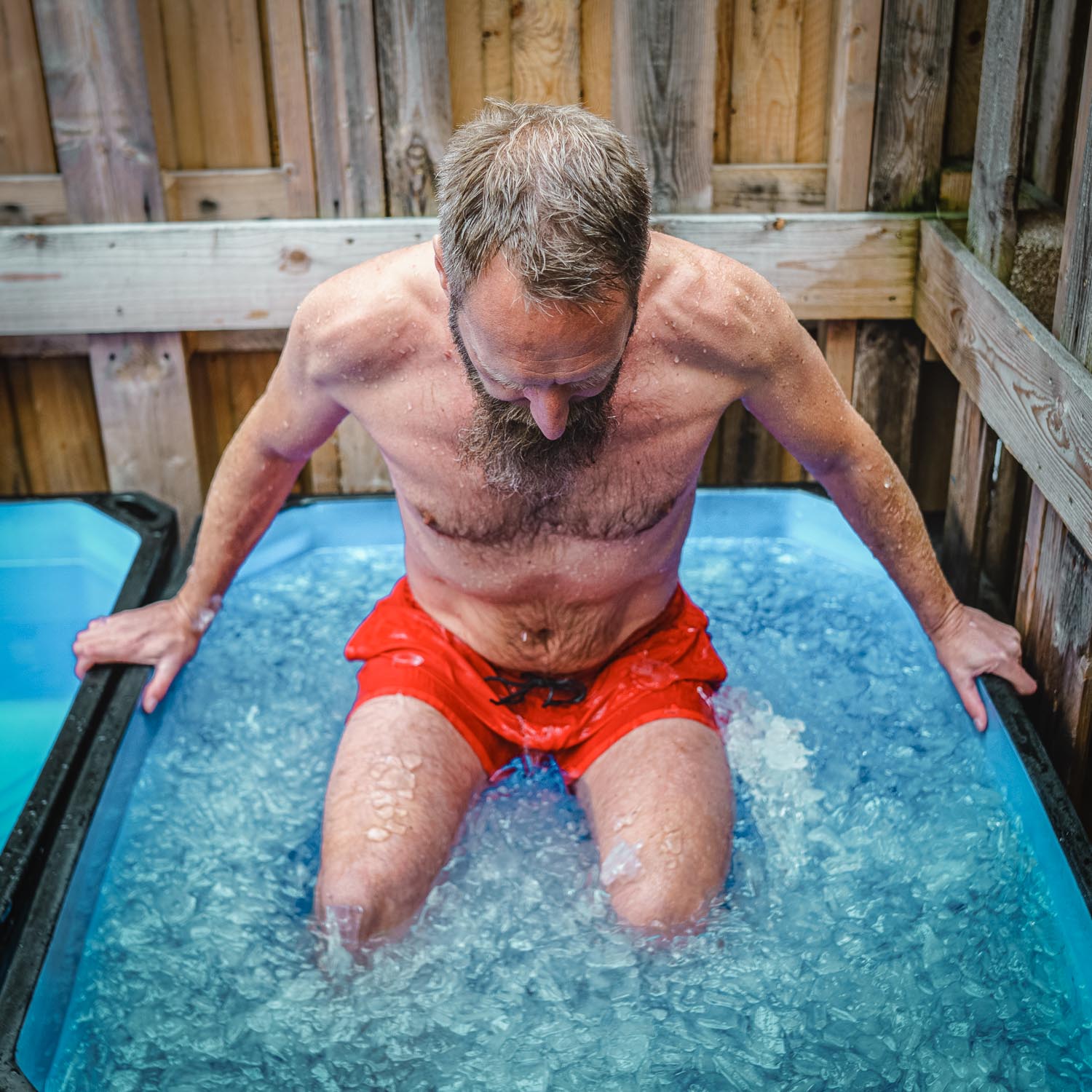Published in:

Germany’s biggest nature travel magazin
cover story | 14 pages | text & photographs

Iceland extreme: ice bath and volcanic eruption
He looked bad. Taken away. Christian had a lot of stress with his girlfriend. He was in the midst of a burnout, which is why he was on sick leave. “You desperately need a change of scene. Do you want to come to Iceland with me?” I asked him. His face brightened. Two weeks later, we met at Kevlavik Airport in the southwest of the island.
Just 30 km away, the Fagradalsfjall volcano erupted at the end of March, after more than 800 years. Neither Christian nor I had ever seen an active volcano, so now we want to take the opportunity. But I still have one more goal: to swim in an ice lagoon. But with training camp first.
Our hands rest in a bowl of ice water. “Focus completely on your breath.”
Christian chases our rental car down the wet tarmac. East of Grindavik, at Suðurstrandarvegur, coastal road No. 427, we park and on foot head for the volcano. After three quarters of an hour of walking through a barren landscape we see a dark gray, lightly fuming lava field. The pungent smell of sulfur fills the air.
Everything ok? Yes. And off into the cubes for three minutes (photo by Frank Nieuwenhuis).
One of the few visitors tells us that we have to climb a ridge to be able to look down into the crater, but that it is not worth it now as the visibility is too low. Disillusioned, we leave again.
Look, the tub is full… of ice
Christian and I kneel on a mat in Andri’s studio with our eyes closed. Our hands rest in a bowl of ice water. “Focus completely on your breath. Stay focused. What you feel is just a cold impulse, don’t let it overtake you.” Impossible to ignore my hands screaming cold. I direct my attention to my breathing rhythm and mentally say ‘In, out, in, out…’
I climb into the tub with a water temperature of ten degrees, notice the uncomfortable coldness of the water, suppress the beginning escape reflex and lie down.
Then Andri instructs us to panic: “Eyes open. Look at your hands. Now you can complain as much as you want. Get really angry! About the cold, the nonsense you’re doing here!” The ranting continues. After a few moments my hands start to hurt even more. Hard to believe if I would not experience it for myself.

Andri shows me a special breathing technique to warm up quickly – rather than just relying on the effect of my clothes (photo by Frank Nieuwenhuis). You can find out more about Andri and his workshops at www.andriiceland.com.
“And now close your eyes again. Focus!”, Andri instructs us. I close my eyes, concentrate on my breath. Shortly after, the cold pain I just conjured up subsides again.
“Do you see what you can control with your thoughts?” says Andri and taps his forehead. “This is where disturbing feelings, cold, discomfort, pain arise – you have it in your hands, or rather in your head. Whether you are stressed or not, your breathing decides.”
After some more exercises, meditations and knowledge transfer from Andri, Christian and I wiggle in bathing suits to the sitting tubs in the outdoor area. I climb into the tub with a water temperature of ten degrees, notice the uncomfortable coldness of the water, suppress the beginning escape reflex and lie down.
“I was hoping for the magic pill. But there was no such thing.”
Only my head remains above water. Focus! After three minutes we change: It’s Christian’s turn. It gets loud, but he pulls it off. Second bath: the four-degree cold tub. And then number three: ice bath! It’s not my first, but Christian’s. He may not believe it yet, but he gets to know himself in thousands of ice cubes by the end of the day.
Surprisingly, it wasn’t the ice bath that felt the coldest. It was the first bath, in ten degrees ‘warm’ water. After the initial immersion and the resulting cold impulse, the blood escapes to the inside of the body to protect the heart and vital organs. In the following baths I felt the cold impulse less intense, because less body-warm blood was being ‘attacked’.

The setting sun paints the sky whilst the Fagradalsfjall eruption joins in with its own contribution (Photo by Timm Chapman).
Deep valleys, crashes, late sun: Andri’s transformation
Andri’s lithe, powerful presence and positive nature seems even more amazing when you know that this man has endured a history of illness that spans nearly thirty years. He began callisthenics and gymnastics at the age of five. At the age of five, he starts gymnastics and gymnastics. Until he fell down a flight of stairs at the age of thirteen: spinal injury ended his gymnastics career. Chronic pain accompanies the adolescent, and the pain only disappears when he drinks alcohol.
He drinks a lot, is ashamed and isolates himself, accompanied by drugs, anxiety disorders and depression. His father dies. Andri is eighteen. Now adding grief, it feeds his despair.
After a few breathing exercises and a mental warm-up, I trudge into the eight-degree cold water.
“I ran from one doctor to another, begging ‘Help me, fix me.’ I was hoping for the magic pill. But there was no such thing,” Andri recalls.
Instead, there were more drugs, more side effects, new diseases, more doctors. In his pill box, he has ten different types of medication. Instead of recovery, he has mood swings, experiences exhaustion, migraines, vomiting, tremors, thirty kilograms of excess weight, a nervous breakdown and suicidal thoughts. He takes sleeping pills, nods off every day while seated, sometimes even while standing.

A natural spectacle that captivates everyone: The crater of Fagradalsfjall continuously ejects lava fountains into the sky.
In 2015, a friend invites him to a breathing workshop. Andri thinks, “Breathing? I’m not a yogi!” But desperate as he is, he also clutches this straw.
The workshop leaves Andri mystified. For the first time he feels a kind of ‘self-energy’, a tool of self-control. Something seems to work, feels right, far removed from any medication. Andri keeps at it and practices different types of breathing exercises every day.
After a few breathing exercises and a mental warm-up, I trudge into the eight-degree cold water.
“I realized that before I did nothing but complain. I believed I needed someone else to get better. Breathing, on the other hand, was a completely new experience. For the first time, I felt like there was something I could control here.”
After three weeks, the pain in his back disappeared, migraine attacks subsided and he lost weight. He kept coming across the name Wim Hof. Andri booked a five-day workshop with Wim Hof in Poland, where he got acquainted with ice baths.
The video shows the breathtaking lava eruption of Iceland’s volcano Fagradalsfjall. Movie was shot with a DJI Mavic drone and edited by me. I also composed the film score.
That was the breakthrough. After his return to Iceland he completed numerous trainings and built a studio in the harbor of Reykjavik. Since then, he has taught more than 3,000 people breathing techniques and ice bathing. “It sounds crazy, but I am cured, entirely through my own strength. I haven’t taken medication for a long time.”
Trial by fire in the lake
The next day, the acid test! We drive south of Reykjavik to Kleifarvatn, an 8 km2 lake. On the black sandy shore we are all by ourselves. After a few breathing exercises and a mental warm-up, I trudge into the eight-degree cold water. Christian skips it, he is still ‘totally happy’ from yesterday’s dose of ice, wants to process everything in peace.
Shivering slightly, I tramp out of the lake, wrap myself in a towel, and wait a few minutes for my body to warm up.
So I paddle back and forth within sight of Andri, swim a few laps and regularly gesticulate that everything is okay. Swimming in cold water is quite ‘another snack’.

The entrance to the ice cave in the Vatnajökull.
My body moves continuously, cold pricking my skin every second. It is much colder than yesterday when i was sitting in the ice bath. Shivering slightly, I tramp out of the lake, wrap myself in a towel, and wait a few minutes for my body to warm up. Then I slip on a shirt, wait again, and slip into a light jacket.
I learned from Andri not to escape immediately into warm winter clothes after a cold bath. This would cause the still cold shell blood to flow back from the ‘outer districts’ into the body core, where it would first have to be warmed up by strong shivering. The resulting cold shivering, in spite of warm clothes, is called ‘afterdrop’.
We dash off, excited as we are faster than yesterday, climb up a ridge and hear a low-frequency crude hissing and puffing in the distance.
Despite the jacket, there is still too much cold in my body. I breathe intensely, grunt, contort myself to produce heat. It takes time. Twenty minutes later Andri smiles at me, pats me on the shoulders and says, “Welcome to ice land!”

The light, the colours and the ice formations of this cave are overwhelmingly beautiful! And ephemeral: every year the glacier melts by about seventy metres.
Lava spraying and joyous rushes
After the bath in the lake, Christian and I jump into the car, turn up the heat and rush off to the volcano parking lot again. Will it work this time? No low-hanging clouds to be seen. We dash off, excited as we are faster than yesterday, climb up a ridge and hear a low-frequency crude hissing and puffing in the distance.
At 6:56 p.m. Christian and I see the first volcanic eruption of our lives!
Then, after just under an hour of walking, the time has come: at 6:56 p.m. Christian and I see the first volcanic eruption of our lives!
The crater of Fagradalsfjall is continuously ejecting lava fountains into the sky. Large parts of the lava land on the inner wall of the crater and drip down thick and slow. It is a natural spectacle that would thrill anyone. The pure fascination of being.
This wild, monstrous force awakens genuine joy in me to which my mind has no access. I stare, with an empty mind and mouth open – humbled, grateful and happy.

A rare aerial perspective over the top, just moments before erupting (Photo by Timm Chapman).
Hot desire: the Fagradalsfjall
Already in January 2020, long before the eruption of Fagradalsfjall, swarm quakes announced an impending volcanic eruption. These barely perceptible quakes were concentrated in a region on the Reykjanes peninsula.
This is considered to be geologically very active, because here the North American and Eurasian earth plates drift apart by one to two centimeters each year. Nevertheless, no eruption has been recorded here for over 800 years. Until earth tremors indicated that things were getting serious: Through fissures and cracks in the earth’s crust, magma forced its way up from greater depths.
Now Iceland had one more attraction. Thousands visited the eruption site, sightseeing flights were quickly booked out, and snack stands and pay for parking lots sprang up along the coastal road.
On March 19, 2021, the first eruption occurred: a fissure eruption. Lava escaped from several vents along a two-kilometer line. On April 5, more fissures opened, and an impressive lava curtain sprayed from the fissure, which was quickly reduced to a few cones that, except for one, became inactive after two days.

Christian on a hike with a view of the massive Svinafellsjökull.
The remaining one grew into a vent and became a superstar. From this single eruption source, vast quantities of lava were now escaping, which could even be seen from Kevlavik International Airport. Now Iceland had one more attraction. Thousands visited the eruption site, sightseeing flights were quickly booked out, and snack stands and pay for parking lots sprang up along the coastal road.
“From May onwards there was the big show from the conveyor vent. Like a geyser, a lava fountain shot up 300 meters every 45 minutes!”
“I’ve been around volcanoes for about three decades, but I’ve never seen anything like it,” geologist Florian Becker tells me. “Scientists were somewhat at a loss, despite the volcanic eruption being so well documented, as the eruption behaviour changed all the time. And that was unique!”.
Eight times he visited the Fagradalsfjall. “From May onwards there was the big show from the conveyor vent. Like a geyser, a lava fountain shot up 300 meters every 45 minutes! After five minutes it was over. That’s totally crazy, that has never been observed with a volcano before!”

View of the glaciers Svinafellsjökull in the foreground and Skaftafellsjökull behind.
Geologically, it can be explained like this: deep down gases diffused by the melt, are being pushed upward in the vent, but not uniformly. At a depth of 500 meters, the gases first collect and then shoot upward, carrying lava with them.
In July, a boiling lava lake took shape in the crater, spilling out over the crater rim and feeding the lava flows. The eruptions were considered relatively harmless because the lava was very thin due to the high temperature of 1,200 degrees and contained little dissolved gas. The latter is incomparably more the case in viscous lava. The danger of explosive gas eruptions, in which even large chunks can be ejected, is then much higher.
Actually I had already put my lagoon challenge ad acta. But Florian was sent by heaven
Then, from the end of August, the changeable Fagradalsfjall remained inactive for several days. Since September 20th nothing is happening anymore. The lava fields are still steaming and the smell of sulfur permeates the air, but the volcano has gone back to sleep.
The brown lagoon
It is raining. Like every day when we are on the road in Iceland. The sun has not apperared even once. Not even during my test bath at Skogafoss. Now we march on the gravel road, closed for cars, which leads to Svinafellsjökull.

Shortly after another test bath in the pool of Skogarfoss. The wind and the spray of the waterfall are enormous, the drops blow partly horizontally – the water drops on the lens testify this.
I follow the tip from Geologist Florian Becker, whom I only met this morning. Originally I wanted to take a bath in Iceland’s most famous glacier lagoon, the Jokulsarlon.
However, that attempt failed due to obtuse authority employees, absurd requirements and a processing speed just above the Reykjanes plate tectonics. Actually I had already put my lagoon challenge ad acta. But Florian was sent by heaven. Being very knowledgeably he suggested bathing alternatives and later helped me to collect volcano facts.
I have to admit, I’m a bit apprehensive for the upcoming bath. But it turns out to be just the right dose: an excited tingle, outside my comfort zone, yet far enough away from panic territory.
At the end of the scree slope, we catch sight of the massive, rutted glacier tongue.
I swim a few meters towards a shallow iceberg when something in the water bumps into me.
It empties into a large milk-coffee-brown lake with a few icebergs floating in it. The many danger and prohibition signs increase my pulse rate.
We make our way through an overgrown path and reach the black lagoon beach.
Focusing myself, I take off my clothes and carefully step into the water. Christian’s presence is a guarantee; I wouldn’t have done it just by myself. I swim a few meters towards a shallow iceberg when something in the water bumps into me. It is a subterranean extension.
Although it is only ten centimeters deep in the water, it cannot be detected in the opaque rubble broth.

Distant view of Svinafellsjökull
I catch myself thinking about climbing the small iceberg. But to do so, I would have to find a place that is safe to step on or climb. Besides, I have no experience in climbing icebergs floating in the water. I do know from a trip to the Arctic that icebergs that seem stable can be completely unstable.
‘Hands off,’ I hear the safety conscious Malte command. I obey and return to shore. Christian holds out his palm to me and we high-five.
On and in the glacier
Amazed, we walk through a completely alien world: fascinating blue-green glowing ice walls, ceilings and domes all around us. A breathtaking, fragile and ephemeral beauty. The meltwater roars past us. We move carefully through Europe’s largest inland glacier, Vatnajökull.
It covers an area of 8,100 square kilometres, which is about 2.2 times the size of Mallorca or 15 times that of Lake Constance.
“Shoot lots of photos, next year the cave will be gone.”
“The meltwater outlets at the many unnamed outlet glaciers are easy access points to the ice caves. They form naturally here due to the slightly elevated temperatures.” explains our guide Olav.
“Shoot lots of photos, next year the cave will be gone.” Because every year the southern ice edge of the glacier melts away by up to 70 meters, our ice cave could very well be unrecognizable next year.

Timm Chapman – photographer of the fascinating volcano pictures. More of this at www.timmchapman.com.
Of course, climate change! From my first trip to Iceland in 1989, I still remember the size of 8,400 square kilometres at the time. Since then, the ice blob has lost the equivalent of about 25,500 square kilometres of ice surface per day. If the melting continues at this rate, in 870 years only a scree field will be left here.
Two months later. I’m on the phone with my wife Annette, telling her about Uganda, where I’m currently traveling. Just before hanging up, she says: “Oh, by the way, Christian is visiting. I don’t know exactly what switch you flipped in Iceland, but he looks really good. He’s lost six kilos, takes cold showers in the morning, played beach volleyball with us and is going to the gym tomorrow. I just call him Christian 2.0!”
I am immensely happy for Christian. That he has followed his intuition and expanded his personal playing field. That in Iceland he has shed some of his old self. And that he now lives self-efficient, joyful and freer.
This is what I wish for every traveler.
Order TERRA MAGAZINE here (only in German):
Print and digital edition
Lesen Sie jetzt:

Article in the Badische Zeitung
Topless on the Feldberg in winter
9 Min. January 2018, Black Forest, Southern Germany: Together with my Ice Buddies I wad through knee-deep snow, jump into ice-cold lakes and finally boot up the snow-covered Feldberg. All topless, mind you. So what’s it about?

5 days 'inner fire'
Ice training with Wim Hof in Poland
< 1 Min. Sixty people from all over the world, including me, learn the fascinating effects of breathing, body exercises and ice baths in 5 days. Highlight: We boot up the Sniezka in shorts. My video summarises the experience.

